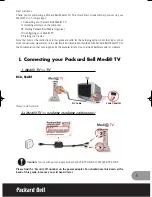
Then, apply 100 watts to the input. Adjust VR40 for 4.5 (4.2 to 4.8 is Ok) volts on test point FWD (to
the right of VR40). The adjustment is fairly course, so you do not need to be exact. Move the dummy load to the
input and apply 100 watts to the output. Adjust VR39 for 4.5 volts on test point REV.
If you can’t get 100 watts out of your radio, use 10 watts and adjust for 1.5 volts. That's it, the AT-11
is now ready to be placed on the air.
Operation Notes: In general, the tuner operation is straight forward and works as described in the
introduction of this manual.
Although rated for 100 watts continuous (the actual max power is about 150 watts at 50% duty
cycle), try to do the tuning with only 10 watts of power (especially if using a tube rig). This will reduce stray
RF and reduce stress on the relays. Solid state radios that automatically fold back the power during high SWR
periods will have no problems. With tube radios, the AT-11 tunes best with 10 watts.
The LEDs will indicate SWR whenever there is more than 2 watts of forward power. If you press the
tune button and there is less than 2 watts of forward power, it will not go to the tune algorithm, but all LEDs
will flash once.
You can use SSB to provide the power for tuning. Just press your mic and say something (like
“Ahhhhhh”) until the AT-11 stops tuning (somewhere between .1 and 6 seconds). If the tuner has a hard time
finding a match or doesn't find 1.5, try using a CW or AM carrier at 10 watts.
If you reach the upper or lower limit of the inductors or capacitors with the manual push buttons, the
LEDs will flash while the button is pressed.
When in the auto mode, if the tuner can not find a better than 3.0 to 1 match, the tuning algorithm will
be repeated until power (either RF or +12) is removed or the mode switch is placed in the semi position.
In either mode, if power (either RF or +12) is removed after the tuning cycle starts, but before it
finishes, the LEDs will go out and the tuning will stop after about 2 seconds. The resultant tune will be
undetermined, it may or may not be a match.
In worse case scenarios where the tuner just barely finds a match, the LEDs may flash with improper
values. This is due to the high stray RF levels on the board. You may want to switch to the semi mode if this
occurs with your antenna system. This will stop the auto function from continually going into the tune
algorithm.
Performance: The actual performance from the small package will surprise you. It really tunes a lot of
5

































